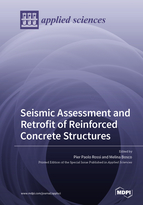Seismic Assessment and Retrofit of Reinforced Concrete Structures
A special issue of Applied Sciences (ISSN 2076-3417). This special issue belongs to the section "Civil Engineering".
Deadline for manuscript submissions: closed (25 March 2022) | Viewed by 28895
Special Issue Editors
Interests: seismic analysis, design, and retrofitting of steel or reinforced concrete buildings; seismic design of bridges; numerical modeling of steel and reinforced concrete members; seismic behavior of in-plan and in-elevation irregular buildings; strength verification/design of reinforced concrete members subjected to combined axial force; bending moment and shear force
Special Issues, Collections and Topics in MDPI journals
Interests: seismic analysis, design, and retrofitting of steel or reinforced concrete buildings; seismic behavior of in-plan and in-elevation irregular buildings; numerical modeling of steel and reinforced concrete members
Special Issues, Collections and Topics in MDPI journals
Special Issue Information
Dear Colleagues,
This Special Issue is open to all kinds of advances and novel applications related to reinforced concrete or prestressed concrete structures in seismic areas. Papers can focus on laboratory tests and numerical modeling of members subjected to cyclic actions as well as on the seismic analysis and assessment of single members, subassembleges or complex structures. The structures considered can be the result of modern or old structural codes and subjected to damage from climatic actions, e.g., to corrosion of longitudinal and transverse reinforcements. The results of the numerical analyses can be elaborated in compliance with deterministic or probabilistic analysis to evaluate the seismic vulnerability, risk or resilience of structures. Particularly welcome are research studies on the seismic retrofitting of structures by means of traditional or innovative methods and loss assessment because of earthquake ground motions.
Prof. Pier Paolo Rossi
Dr. Melina Bosco
Guest Editors
Manuscript Submission Information
Manuscripts should be submitted online at www.mdpi.com by registering and logging in to this website. Once you are registered, click here to go to the submission form. Manuscripts can be submitted until the deadline. All submissions that pass pre-check are peer-reviewed. Accepted papers will be published continuously in the journal (as soon as accepted) and will be listed together on the special issue website. Research articles, review articles as well as short communications are invited. For planned papers, a title and short abstract (about 100 words) can be sent to the Editorial Office for announcement on this website.
Submitted manuscripts should not have been published previously, nor be under consideration for publication elsewhere (except conference proceedings papers). All manuscripts are thoroughly refereed through a single-blind peer-review process. A guide for authors and other relevant information for submission of manuscripts is available on the Instructions for Authors page. Applied Sciences is an international peer-reviewed open access semimonthly journal published by MDPI.
Please visit the Instructions for Authors page before submitting a manuscript. The Article Processing Charge (APC) for publication in this open access journal is 2400 CHF (Swiss Francs). Submitted papers should be well formatted and use good English. Authors may use MDPI's English editing service prior to publication or during author revisions.
Keywords
- reinforced concrete
- prestressed concrete
- laboratory tests
- numerical modeling
- seismic assessment
- seismic retrofit







